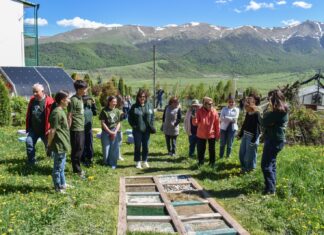YEREVAN — Polish contemporary art group Instytut B61 capped off Yerevan’s much touted recent STARMUS science festival with an interactive performance which invited guests to visualize the journey of a star.
Instytut B61, the brainchild of polish astronomer-turned-art curator Jan Świerkowski, turns to immersive, site-specific performances and multimedia shows combining art, science and technology to make science, and astronomy in particular, more accessible to the general public. Citing inspiration from famous “science communicators” like Carl Sagan and Neil DeGrasse Tyson, the group, which met at the science faculty at Poland’s Copernicus University, felt that art offered the best way to connect humans with their place in the universe. “Astronomy deserves to be cooler than just a scientist talking on TV,” Świerkowski said in a recent interview.
The performance, which was held between September 7 and 11, took place as part of the STARMUS science and art festival organized in the Armenian capital, with some events also taking place in Lori Province (Marz).
The festival aims to, according to their website, “inspire and educate the next generation of explorers and regenerate the spirit of discovery”. Among the speakers at this year’s festival were astronaut and moon-walker Charlie Duke, former NASA boss Charles Bolden, Nobel Prize laureate Donna Strickland and the first Armenian in space, Jim Bagian. Dr. Garik Israelian, founder of the Starmus Festival, was also joined by artists including Serj Tankian and Queen Guitarist Bryan May, who is also an astrophysicist.
Building on a history of strong talent in science, mathematics and technology, the Armenian government has sought to foster what it sees as a strategic human resource. In 2021, the Armenian Government raised its science and education budget by almost $7 million, while the European Union has also offered financial support for the Armenian scientific community as part of its Research and Innovation Framework. Much emphasis has been placed on reintroducing science to the next generation after years of financial and educational neglect following the breakup of the Soviet Union. Science festivals like STARMUS have been tagged as key elements in this strategy.
“Everyone experiences the stars differently”, Świerkowski explains. His performance, entitled ‘The Evolution of the Stars’, was pegged as a unique immersive experience communicating complex scientific phenomena using accessible yet spectacular multimodal metaphors, using a variety of senses to communicate the essence of astrophysics. The event was preceded by a three-week artists in residence program in Yerevan that included extensive collaboration between artists and scientists. Among collaborators were the famous traditional Armenian band the Gurdjieff Ensemble,

Photo credit: Adrian Chmielewski








